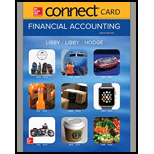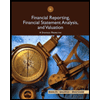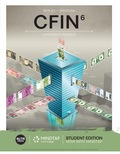
Connect Access Card for Financial Accounting
9th Edition
ISBN: 9781259738678
Author: Robert Libby, Patricia Libby, Frank Hodge Ch
Publisher: McGraw-Hill Education
expand_more
expand_more
format_list_bulleted
Question
Chapter 10, Problem 10.1P
1.
To determine
Calculate Corporation A’s current debt-to-equity ratio.
2.
To determine
Calculate Corporation A’s debt-to-equity ratio, if the company funds the project using $100,000 of additional debt.
3.
To determine
Calculate Corporation A’s debt-to-equity ratio, if the company funds the project by issuing $100,000 of common stock.
4.
To determine
Write the recommendation for fund the project by Corporation A.
Expert Solution & Answer
Want to see the full answer?
Check out a sample textbook solution
Students have asked these similar questions
Please give me true answer this financial accounting question
Yankee Fixtures has received a special one-time order for 1,800 light fixtures at $4.50 per unit. Yankee currently produces and sells 6,000 units at $6.00 each. This level represents 80% of its capacity. Production costs for these units are $3.20 per unit, which includes $1.30 variable cost and $1.90 fixed cost. To produce the special order, a new tool must be purchased at a cost of $1,400 with zero salvage value. Management expects no other cost changes as a result of the additional production. If Yankee wishes to earn $1,300 on the special order, how many units would need to be sold? (Round your answer to nearest number)
Please show me the correct way to solve this financial accounting problem with accurate methods.
Chapter 10 Solutions
Connect Access Card for Financial Accounting
Ch. 10 - From the perspective of the issuer, what are some...Ch. 10 - What are the primary characteristics of a bond?...Ch. 10 - Prob. 3QCh. 10 - Differentiate between a bond indenture and a bond...Ch. 10 - Prob. 5QCh. 10 - Prob. 6QCh. 10 - Prob. 7QCh. 10 - Prob. 8QCh. 10 - What is the book value of a bond?Ch. 10 - Prob. 10Q
Ch. 10 - Prob. 11QCh. 10 - Prob. 12QCh. 10 - Prob. 1MCQCh. 10 - Prob. 2MCQCh. 10 - Prob. 3MCQCh. 10 - Prob. 4MCQCh. 10 - Prob. 5MCQCh. 10 - Prob. 6MCQCh. 10 - Prob. 7MCQCh. 10 - Prob. 8MCQCh. 10 - Prob. 9MCQCh. 10 - Prob. 10MCQCh. 10 - Prob. 10.1MECh. 10 - Computing the Price of a Bond Issued at Par LO10-2...Ch. 10 - Understanding Financial Ratios 0-3, 10-6 The...Ch. 10 - Computing the Times Interest Earned Ratio LO10-3...Ch. 10 - Computing the Price of a Bond Issued at a Discount...Ch. 10 - Recording the Issuance and Interest Payments of a...Ch. 10 - Prob. 10.7MECh. 10 - Prob. 10.8MECh. 10 - Prob. 10.9MECh. 10 - Prob. 10.10MECh. 10 - Prob. 10.11MECh. 10 - Prob. 10.12MECh. 10 - Prob. 10.13MECh. 10 - Prob. 10.14MECh. 10 - Prob. 10.1ECh. 10 - Prob. 10.2ECh. 10 - Prob. 10.3ECh. 10 - Computing Issue Prices of Bonds Sold at Par, at a...Ch. 10 - Prob. 10.5ECh. 10 - Prob. 10.6ECh. 10 - Prob. 10.7ECh. 10 - Prob. 10.8ECh. 10 - (Chapter Supplement) Recording and Reporting a...Ch. 10 - Prob. 10.10ECh. 10 - Prob. 10.11ECh. 10 - Explaining Why Debt Is Issued at a Price Other...Ch. 10 - Prob. 10.13ECh. 10 - Prob. 10.14ECh. 10 - Prob. 10.15ECh. 10 - Prob. 10.16ECh. 10 - Prob. 10.17ECh. 10 - Prob. 10.18ECh. 10 - Prob. 10.19ECh. 10 - Prob. 10.20ECh. 10 - Prob. 10.21ECh. 10 - Prob. 10.22ECh. 10 - Prob. 10.23ECh. 10 - Prob. 10.24ECh. 10 - Prob. 10.1PCh. 10 - Prob. 10.2PCh. 10 - Comparing Bonds Issued at Par, at a Discount, and...Ch. 10 - Prob. 10.4PCh. 10 - Prob. 10.5PCh. 10 - Recording and Reporting Bonds Issued at a Discount...Ch. 10 - Recording and Reporting a Bond Issued at a...Ch. 10 - Prob. 10.8PCh. 10 - Prob. 10.9PCh. 10 - Prob. 10.10PCh. 10 - Prob. 10.11PCh. 10 - Prob. 10.12PCh. 10 - Prob. 10.13PCh. 10 - Prob. 10.14PCh. 10 - Prob. 10.15PCh. 10 - Prob. 10.16PCh. 10 - Prob. 10.1APCh. 10 - Prob. 10.2APCh. 10 - Prob. 10.3APCh. 10 - Prob. 10.4APCh. 10 - Prob. 10.5APCh. 10 - Prob. 10.6APCh. 10 - Recording and Reporting a Bond Issued at a Premium...Ch. 10 - Prob. 10.8APCh. 10 - Prob. 10.1CONCh. 10 - Prob. 10.1CPCh. 10 - Prob. 10.2CPCh. 10 - Prob. 10.3CPCh. 10 - Prob. 10.4CPCh. 10 - Prob. 10.5CPCh. 10 - Evaluating an Ethical Dilemma LO 10-1 Assume that...
Knowledge Booster
Learn more about
Need a deep-dive on the concept behind this application? Look no further. Learn more about this topic, accounting and related others by exploring similar questions and additional content below.Similar questions
- Please explain the correct approach for solving this general accounting question.arrow_forwardCan you help me solve this financial accounting question using valid financial accounting techniques?arrow_forwardA piece of equipment that was originally purchased for $29,400, had accumulated depreciation of $19,150, and was sold for $9,200, would recognize a gain of $1,500. a. True. b. False.arrow_forward
- The balance sheet of Armani Systems at December 31 showed assets of $75,000 and shareholders equity of $45,000. What were the liabilities at December 31? a. $40,000 b. $30,000arrow_forward1. How does using an accounting system enable separation of duties? 2. What are the benefits of an ERP system? 3. What are the benefits of QuickBooks?arrow_forwardWhat is the gross profit for the period?arrow_forward
arrow_back_ios
SEE MORE QUESTIONS
arrow_forward_ios
Recommended textbooks for you
 Financial Reporting, Financial Statement Analysis...FinanceISBN:9781285190907Author:James M. Wahlen, Stephen P. Baginski, Mark BradshawPublisher:Cengage Learning
Financial Reporting, Financial Statement Analysis...FinanceISBN:9781285190907Author:James M. Wahlen, Stephen P. Baginski, Mark BradshawPublisher:Cengage Learning
 EBK CONTEMPORARY FINANCIAL MANAGEMENTFinanceISBN:9781337514835Author:MOYERPublisher:CENGAGE LEARNING - CONSIGNMENT
EBK CONTEMPORARY FINANCIAL MANAGEMENTFinanceISBN:9781337514835Author:MOYERPublisher:CENGAGE LEARNING - CONSIGNMENT

Financial Reporting, Financial Statement Analysis...
Finance
ISBN:9781285190907
Author:James M. Wahlen, Stephen P. Baginski, Mark Bradshaw
Publisher:Cengage Learning


EBK CONTEMPORARY FINANCIAL MANAGEMENT
Finance
ISBN:9781337514835
Author:MOYER
Publisher:CENGAGE LEARNING - CONSIGNMENT
What Are Stock Buybacks and Why Are They Controversial?; Author: TD Ameritrade;https://www.youtube.com/watch?v=2O4bmcliaog;License: Standard youtube license